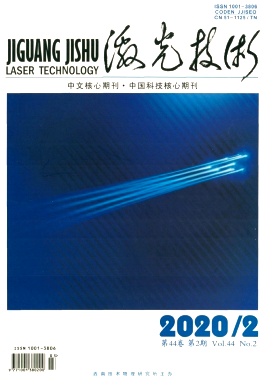HTML
-
喇曼散射光谱是一种无损、快速检测物质成分的方法。喇曼光谱可以同时检测多种气体的成分,所以常被用于医疗检查[1]、燃气成分检查[2]、化学反应监测[3]、高分辨率光谱实验[4]等领域。但是, 当喇曼光谱被用于检测气体时,由于散射信号十分微弱,信号易受背景荧光干扰,不利于在生活和工业现场进行检测。
激发光波长越短,信号光越强;激发光作用长度越长,信号越强。所以,常常使用大功率短波长的激光器激发,用长程腔作气体池[5],增大信号强度。
大功率激光器和长程气体池价格昂贵、体积庞大,不利于广泛使用。本文中研究半导体激光器的外腔增强。使用半导体激光器外腔增强能有效增大激发光功率,而且价格便宜、体积小。该方案由KING等人提出[6],他们使用的半导体激光器初始光强为10mW,在外腔中放大了10000倍,变成100W的激光。后来,OHARA等人[7-8]和KEINER等人[3, 9-10]也建立了类似的装置,外腔功率达到80W,获得了纯氮气的喇曼散射光谱。HIPPLER等人[11-13]提出了伺服电路半导体外腔增强的方案,获得了2.5W的外腔功率,另外,他们使用的是单纵模外腔半导体激光器,检测分辨率大大提高,获得了清晰的空气喇曼散射光谱和天然气喇曼散射光谱。本文中提出了一种新的外腔增强方案,利用了光反馈原理,使外腔被动锁定。本方中案具有结构简单,效果好的优点。
-
自发喇曼散射的信号强度I与激发光光强、激发光波长和收集立体角等参量有关。公式如下:
式中,I是信号强度,Ilaser是激发光光强,n是气体分子密度,leff是激发光作用长度,$\frac{\mathrm{d} \sigma_{\mathrm{R}}}{\mathrm{d} \mathit{\Omega}} $是微分喇曼散射截面,Ω是收集立体角。喇曼散射截面与激发光波长有关,关系是: ${\sigma _{\rm{R}}}(\lambda ) \sim {\left( {\frac{1}{\lambda }} \right)^4} $。
基于半导体激光器共振外腔的喇曼散射实验装置如图 1所示。该装置包括腔增强装置与喇曼光谱检测系统。试验中,采用90°构型收集喇曼散射光。使用的激光器是无减反膜处理的半导体激光二极管(laser diode,LD)(CLD405500K, NICHIA),波长在408nm左右,线宽为0.9nm, 最大功率为500mW。激光被准直透镜(C671TME-405, Thorlabs)耦合入外腔,焦距为4.01mm。外腔由两块球面镜组成,曲率半径为50mm,R1的反射率为96.5%,R2的反射率为99.5%,两球面镜相隔50mm摆放。透镜L2在外腔的旁侧,用于收集喇曼散射光,焦距为40mm。长通滤光片F(BLP01-405R-25,Sem-rock)用于滤除漫反射光和瑞利散射光。使用的光谱仪是实验室自制的光谱仪[14]。
-
使用共焦法布里-珀罗(Fabry-Perot,F-P)腔作为外腔。当激光注入F-P腔时,若想让激光在F-P腔内积累,并透过F-P腔,需要进行模式匹配,包括横模匹配(注入激光束光强分布与共振外腔横模的匹配)和纵模匹配(注入激光束频率与共振外腔)。
匹配的方法如下:把激光聚焦,使得束腰半径w1等于共焦腔本征模式的束腰半径w0,使光束的波前和腔镜相重合。试验中把激光器出射光束的慢轴聚焦为50μm,共焦腔本征模式的束腰半径为46μm。由于使用的是对称共焦腔,对称共焦腔具有自再现传输的功能,所以对模式匹配的要求不高,仅需要w1大致等于w0。
按如下的方式考虑纵模匹配。外腔形成驻波腔,自由光谱范围为:
式中,c是光速,L为外腔腔长,由于L=50mm,νFSR=3GHz。
精细度公式为:
左腔镜的反射率R1=96.5%, 右腔镜的反射率R2=99.5%, 精细度大概为160。带宽Δν易得:
求得带宽Δν=18.75MHz。
所使用的激光器的线宽为1716.5GHz左右,纵模间隔大概为48.9GHz。从自由光谱范围上来看,由于外腔和激光器的自由光谱范围相差很大,光线中的大部分无法透过外腔,但是由于半导体激光器的光反馈效应,半导体激光器的出射波长会受外界光影响,半导体激光器和外腔相同波长的光线会得到反馈和增强,内外腔形成共振,光线能够透过外腔。
为了使腔镜3的直接反射光不直接返回激光器,干扰光反馈,共焦腔与光轴倾斜摆放[15-17],具体光路如图 2所示。
光束Ⅱ倾斜射出,外腔出射的光束Ⅰ返回激光器,形成光反馈。
外输入光功率P1=500mW,输出功率P2=38mW,反射率R =98%,腔内总功率P3=P2/(1-R), 求得腔内单向功率为7.5W,总功率为15W, 腔内功率增强倍数为30。
-
直接在实验室的空气环境中进行实验。经过对准和聚焦之后,积分50s,在CCD中获得了如图 3所示的图像。
图 3中,左边白线是泄漏的激发光和瑞利散射信号,从左往右两个白点依次是O2、N2信号。
积分时间1s,获得光谱,扣除基线后得到图 4。
在图 4中,能清晰看到O2, N2, H2O信号。去除基线后,1s积分时间,获得N2信号900个计数,说明在1s这样短的积分时间内,能获得比较强的喇曼散射信号,这说明了共振腔有效地增强了信号。另外,基线比较平坦,说明荧光背景比较弱,这有利于提高检测灵敏度,用于痕量气体的分析。
积分50s获得光谱,扣除基线获得图 5。
积分50s的情况下,以3000cm-1~3300cm-1范围内的平均强度为基线,获得N2信号强度为31792。以其标准偏差为噪声,得到信噪比为1989。信号的分辨率为40cm-1。
积分50s的光谱细节图如图 6所示。
如图 6所示,1处信号为激发光信号;2处的阶梯形状是长通滤光片的作用造成,在这之前荧光背景较弱,在这之后荧光背景较为明显;3处信号为SiO2; 4处信号为O2;5处信号为N2;6处信号经过前后对比,为激发光的信号;7处信号为H2O;8处信号在4600cm-1附近,它的来源还有待分析。
2.1. 腔共振增强原理
2.2. 空气喇曼散射探测
-
为了提高自发喇曼散射的信号强度,本文中设计了一套半导体激光器外腔增强腔,并开展了就该装置的空气喇曼实验。实验结果表明,共振腔将激光功率放大约30倍,喇曼信号显著增强,信噪比高。
由于使用的是被动式光反馈腔增强原理,装置不需要电路辅助,装置简单、可靠性好,而且抗振动能力强,能长时间保持腔增强状态。
在空气喇曼实验中,积分时间1s即获得了强烈的喇曼散射信号。但是由于激发光的线宽比较宽,使得检测分辨率只有40cm-1。这一分辨率无法用于多种燃气混合气体检测。
压窄半导体激光器的线宽有许多方法,比如双折射滤光片、干涉滤光片、标准具等。这些器件有一个窄的透射峰,通过减小部分波长透过率,使部分波长起振,激光线宽变窄。
在后续研究中,将采取措施压窄激发光线宽,提高检测分辨本领,拓宽该装置的应用范围。

 Map
Map










 DownLoad:
DownLoad:




